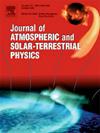达曼,沙特阿拉伯的大气温度逆温动力学:长期特征和趋势
IF 1.9
4区 地球科学
Q3 GEOCHEMISTRY & GEOPHYSICS
Journal of Atmospheric and Solar-Terrestrial Physics
Pub Date : 2025-09-24
DOI:10.1016/j.jastp.2025.106645
引用次数: 0
摘要
本文研究了1985年至2023年38年间沙特阿拉伯达曼(26.4°N, 50.1°E) 5000 m以下气温的时间变率,利用探空数据分析了6个关键变量:基线高度(Hi)、最高高度(Hf)、基线温度(Ti)、最高高度温度(Tf)、高差(DH)和温差(DT)。考虑到发生在5000 m以下且DT大于1 C的逆温事件,共识别和研究了13744个逆温事件。分析显示主要的低空逆温(76.07%在1000米以下)和强烈的夜间发生(约70%)。高空逆温呈现出Hi(冬季1900±100 m,夏季2500±100 m)和Ti(1月5.98±2.0°C, 6月22.30±2.0°C)的季节变化,Hf持续升高200-300 m, Tf持续升高2-3°C。年DH在170±50 ~ 220±50 m之间,夜间低空逆温显示最大的稳定垂直范围(296±23 m)。逆温频率随着时间的推移而增加,特别是在高海拔地区,Mann-Kendall和回归分析证实了这种强劲的趋势(91.7%的一致性)。这些模式由辐射冷却、海陆风和城市热岛效应驱动,对达曼沿海沙漠环境的空气质量和城市规划具有重要意义。本文章由计算机程序翻译,如有差异,请以英文原文为准。
Dynamics of atmospheric temperature inversions in Dammam, Saudi Arabia: Long-term characterization and trends
This study investigates the temporal variability of temperature inversions below 5000 m in Dammam, Saudi Arabia(26.4°N, 50.1°E), over a 38-year period from 1985 to 2023, using radiosonde data to analyze six critical variables: base height (Hi), maximum height (Hf), temperature at the base (Ti), temperature at the maximum height (Tf), height difference (DH), and temperature difference (DT). Considering the temperature inversions occurred below 5000 m and with DT greater than 1 C, a total of 13744 temperature inversion events were recognized and investigated. Analysis revealed predominant low-level inversions (76.07 % below 1000 m) with strong nocturnal occurrence (∼70 %). High-level inversions showed seasonal variations in Hi (1900 ± 100 m in winter, 2500 ± 100 m in summer) and Ti (5.98 ± 2.0 °C in January, 22.30 ± 2.0 °C in June), with Hf consistently 200–300 m higher and Tf 2–3 °C warmer. DH ranged annually between 170 ± 50 m and 220 ± 50 m, with nocturnal low-level inversions showing the largest stable vertical extent (296 ± 23 m). Inversion frequencies increased over time, particularly at higher altitudes, with robust trends confirmed by Mann-Kendall and regression analyses (91.7 % concordance). These patterns, driven by radiative cooling, sea-land breezes, and urban heat island effects, suggest significant implications for air quality and urban planning in Dammam's coastal desert environment.
求助全文
通过发布文献求助,成功后即可免费获取论文全文。
去求助
来源期刊

Journal of Atmospheric and Solar-Terrestrial Physics
地学-地球化学与地球物理
CiteScore
4.10
自引率
5.30%
发文量
95
审稿时长
6 months
期刊介绍:
The Journal of Atmospheric and Solar-Terrestrial Physics (JASTP) is an international journal concerned with the inter-disciplinary science of the Earth''s atmospheric and space environment, especially the highly varied and highly variable physical phenomena that occur in this natural laboratory and the processes that couple them.
The journal covers the physical processes operating in the troposphere, stratosphere, mesosphere, thermosphere, ionosphere, magnetosphere, the Sun, interplanetary medium, and heliosphere. Phenomena occurring in other "spheres", solar influences on climate, and supporting laboratory measurements are also considered. The journal deals especially with the coupling between the different regions.
Solar flares, coronal mass ejections, and other energetic events on the Sun create interesting and important perturbations in the near-Earth space environment. The physics of such "space weather" is central to the Journal of Atmospheric and Solar-Terrestrial Physics and the journal welcomes papers that lead in the direction of a predictive understanding of the coupled system. Regarding the upper atmosphere, the subjects of aeronomy, geomagnetism and geoelectricity, auroral phenomena, radio wave propagation, and plasma instabilities, are examples within the broad field of solar-terrestrial physics which emphasise the energy exchange between the solar wind, the magnetospheric and ionospheric plasmas, and the neutral gas. In the lower atmosphere, topics covered range from mesoscale to global scale dynamics, to atmospheric electricity, lightning and its effects, and to anthropogenic changes.
 求助内容:
求助内容: 应助结果提醒方式:
应助结果提醒方式:


